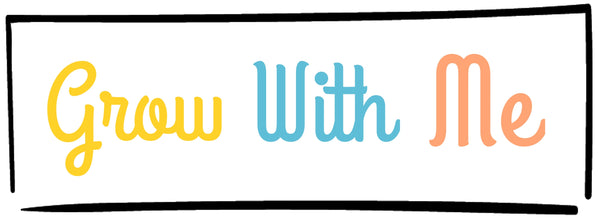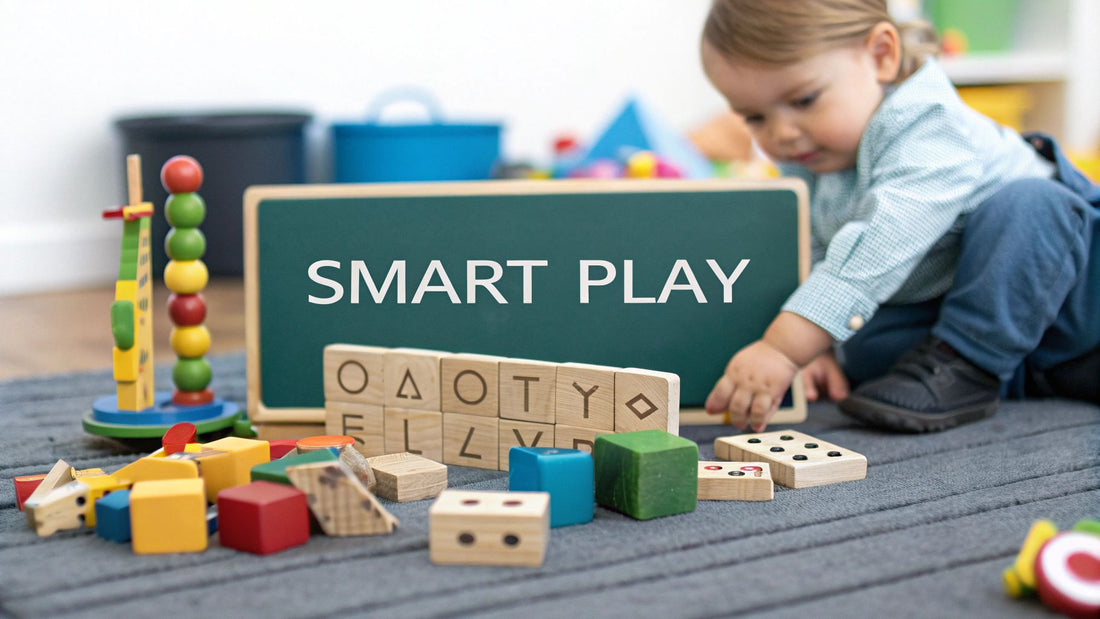
Top Learning Toys for 2 Year Olds | Boost Development
Share
The best learning toys for 2 year old children aren't always the flashiest or loudest. They're the ones that tap into a toddler's boundless curiosity and support their explosive development. Simple things like building blocks, chunky puzzles, and sensory toys are fantastic because they turn playtime into a powerhouse for learning.
Why Play Is Your Toddler's Most Important Job
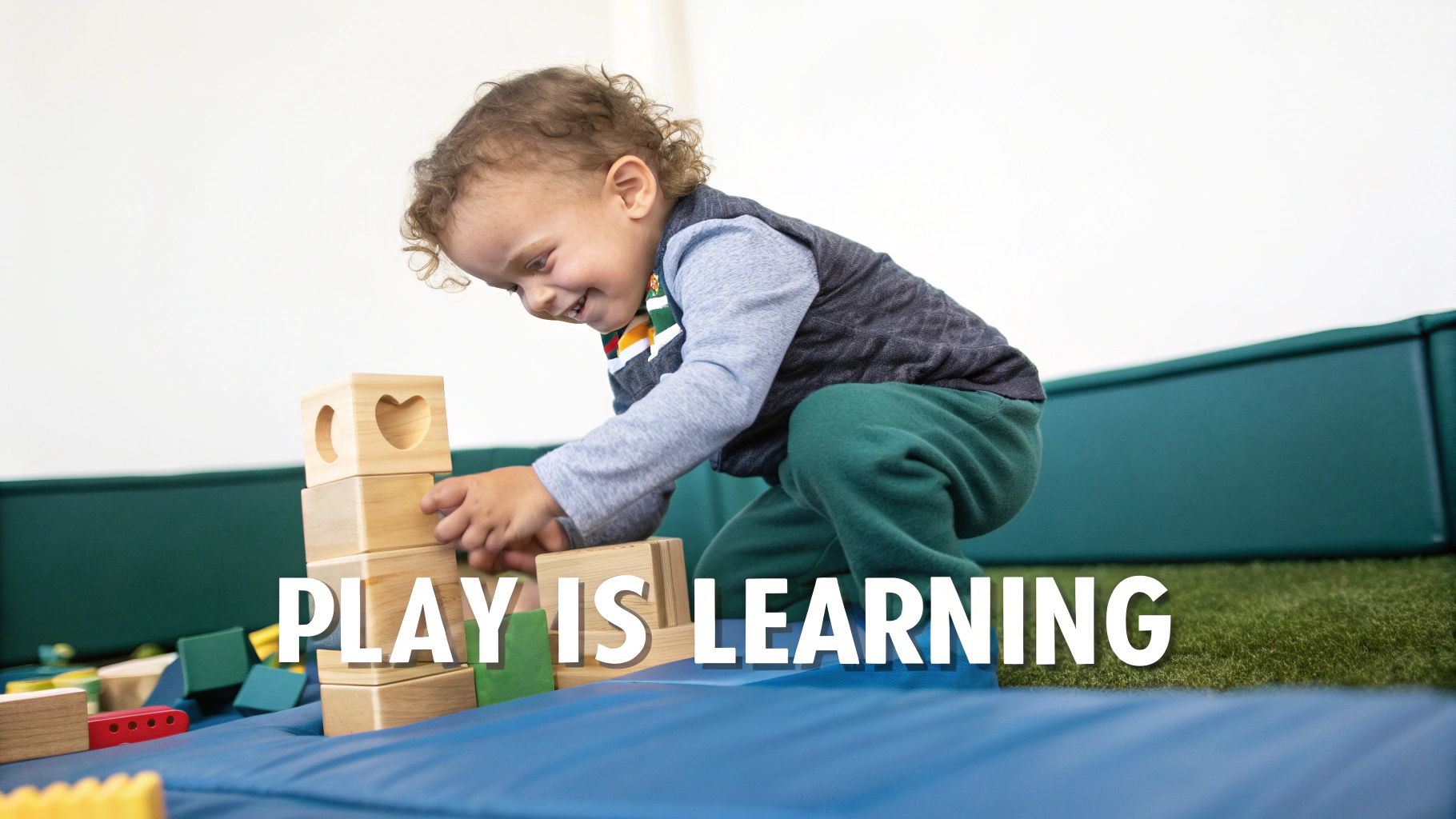
Welcome to the wonderful, whirlwind world of a two-year-old. This age is a period of incredible change, where every single interaction—from stacking colourful blocks to splashing water in the garden—is a vital piece of their development puzzle. For a toddler, play isn't just a bit of fun. It’s their full-time job.
It’s through this playful exploration that they start to grasp big ideas like cause and effect, figure out what their bodies can do, and learn how to express themselves. This stage is absolutely packed with developmental leaps.
Key Milestones at Age Two
You're probably noticing an explosion of new skills in your toddler right now. Their vocabulary seems to grow overnight, they're running and climbing with newfound confidence, and you can see their little minds working to solve simple problems. This is where learning toys come in. They aren't just objects; they are the perfect tools to support this amazing journey.
- Cognitive Growth: Simple puzzles and shape sorters are brilliant for introducing early logic and understanding how things fit together.
- Motor Skills: Things like stacking rings or threading chunky beads help to hone the fine motor control they’ll one day need for writing.
- Language and Social Skills: Pretend play with a toy kitchen or dolls is fantastic for encouraging storytelling and empathy.
For a two-year-old, a set of building blocks is so much more than just wood. It’s a hands-on physics lesson, a canvas for creativity, and a chance to learn about sharing and working together.
The Growing Importance of Developmental Play
More and more, parents are realising just how crucial these early years are for building a solid foundation for future learning. This shift is clear in the toy market, with demand for good-quality developmental toys on the rise. In fact, the UK baby toys market, which includes learning toys for 2 year old children, was valued at around USD 821.5 million in 2024 and is expected to keep growing. You can dive deeper into these trends in this detailed market analysis.
By choosing the right tools, you're not just giving them a toy; you're helping make learning a joyful, natural part of their day. If you’re looking for more inspiration, you might enjoy our guide to sensory play ideas for toddlers.
Understanding Your Two-Year-Old's Development
At two years old, your child's brain is an absolute whirlwind of activity, forging new connections every single second. Getting a handle on their developmental journey is a bit like having a map; it shows you where they are, where they're headed, and how the right learning toys for 2 year old children can be the perfect companions for their adventure.
It's easy to see their development as just one big, chaotic blur. Instead, it helps to break it down. Think of it like building a house: you need a solid foundation (their motor skills), sturdy walls (their cognitive abilities), and a warm, welcoming interior (their social and emotional growth). Each part is different, but they all work together to create a complete, happy little person.
This diagram helps to show how these crucial areas are all linked.
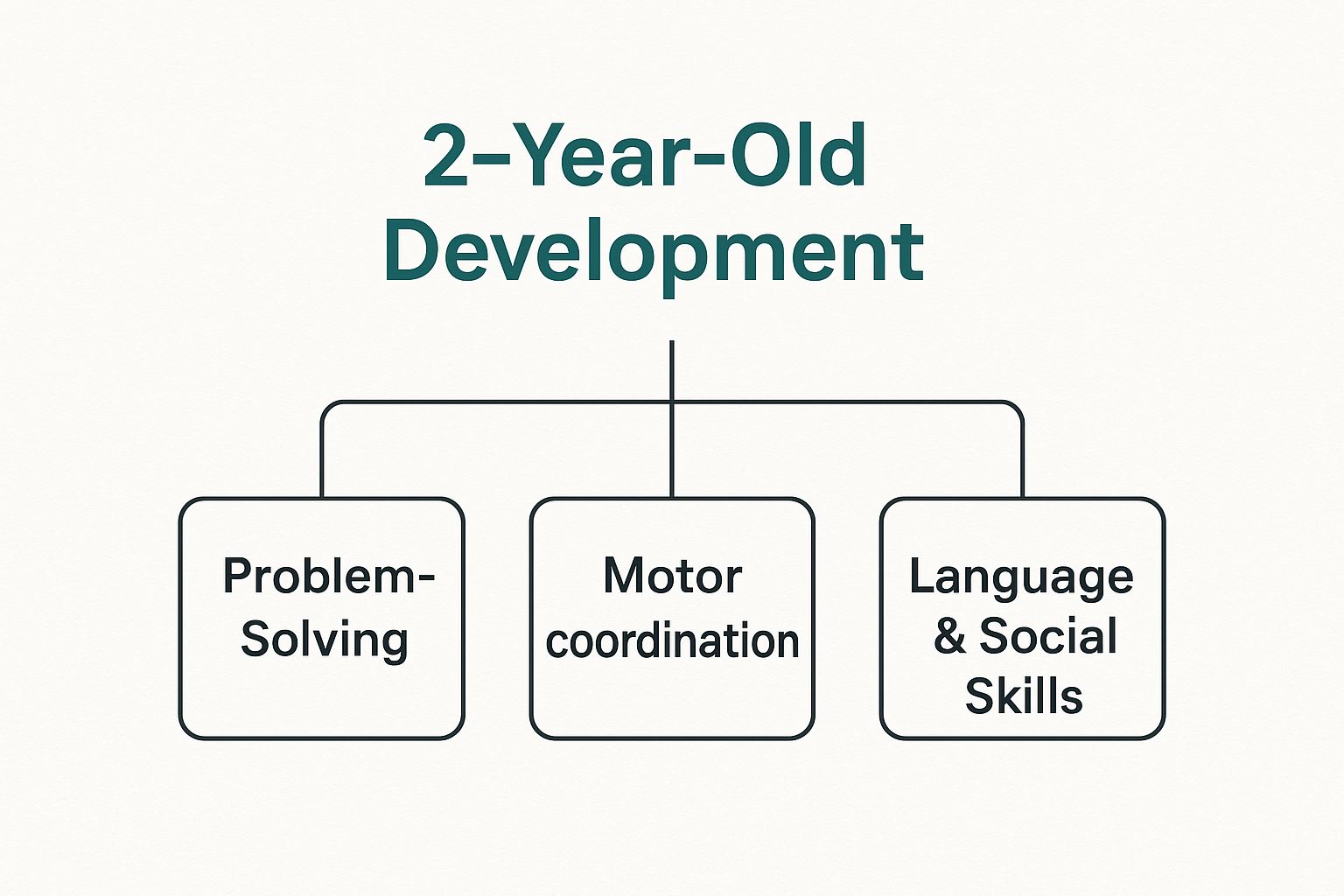
As you can see, problem-solving, physical coordination, and social skills really are the three core pillars holding up your toddler's world at this stage.
The Little Problem Solver
A two-year-old's world is one giant puzzle they are constantly trying to piece together. When they stubbornly try to jam a square block into a round hole, they're not just playing around—they're running a tiny scientific experiment. This is their cognitive development in action, all built on the idea of cause and effect.
They’re figuring out that pushing a button makes a funny noise, or that stacking blocks just one too high will send them crashing down. Simple puzzles, shape sorters, and building blocks aren't just toys; they are the essential tools for building their first sense of logic and reason. You’ll probably notice them starting to group toys by colour or size, a sure sign they’re learning to categorise and make sense of their surroundings.
Mastering Movement Big and Small
Physical development at this age shoots off in two exciting directions: gross motor skills and fine motor skills. Gross motor skills are all about the big muscles—the ones they use for running, jumping, and climbing. You'll see this in full force when they fearlessly attempt to scale the sofa or joyfully kick a ball across the garden.
Fine motor skills, on the other hand, are about the small, precise muscles in their hands and fingers. This is the delicate control needed to pick up a single pea from their plate or carefully turn the page of a book. Stacking rings, threading chunky beads, or scribbling with chunky crayons are fantastic for strengthening these little muscles. If you're looking for more inspiration, you might find our guide on fine motor skills development activities helpful.
A two-year-old’s desire to constantly carry, stack, and move objects is not random. It's their brain's way of mastering spatial awareness and coordination through a powerful urge developmental experts call a "play schema."
The Language and Social Explosion
Around their second birthday, many toddlers experience a vocabulary explosion, sometimes picking up several new words every day. They start stringing words together into short, powerful sentences like "more juice" or "daddy go." This is also when pretend play suddenly becomes a huge part of their world.
When they 'feed' their teddy bear or 'chat' on a toy phone, they're practising social roles and building the foundations of empathy. This imaginative play is their safe space for exploring big emotions and complex interactions. And it's not just about toys; sharing stories is a wonderful way to expand their emotional world. You can discover more about great books about feelings for toddlers that can help nurture their emotional vocabulary.
Choosing the Best Types of Learning Toys
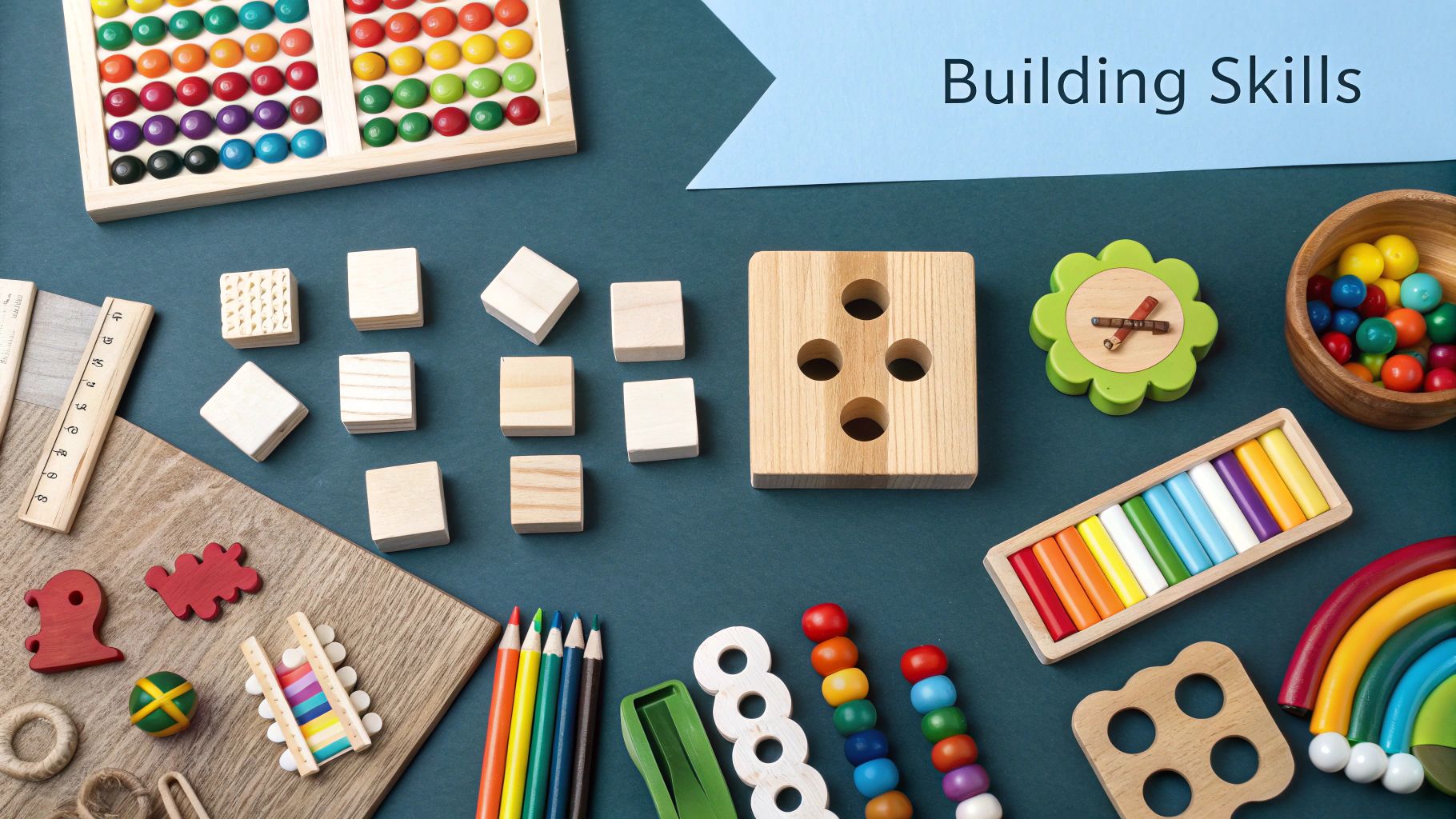
Stepping into a toy shop can feel a bit overwhelming. The shelves are packed with endless options, all promising to be the "best" for your child. The trick is to look past the flashy packaging and think about the type of play each toy actually encourages. The best learning toys for a 2 year old fall into a few key categories, each one perfectly tuned to where they are in their development right now.
Think of it like stocking your kitchen. You need a mix of different ingredients to cook a variety of healthy, interesting meals. In the same way, a well-rounded toy collection provides different kinds of "nutrients" for your toddler's rapidly growing brain.
Building and Construction Toys
For a reason, building blocks are the undisputed champions of the toddler toy box. When your two-year-old is busy stacking a tower, they're doing far more than just playing—they're running their own little hands-on physics experiment. With every wobbly stack and dramatic tumble, they're learning about balance, gravity, and spatial awareness.
These toys are absolute powerhouses for developing fine motor skills and hand-eye coordination. Better still, they are a fantastic canvas for problem-solving. "How can I make my tower taller without it falling over?" That simple question is the very beginning of early engineering skills.
The popularity of these toys is clear. In 2023, the educational toys market in the UK generated revenues over £3.3 billion, with building sets making up the largest share at over 21%.
Puzzles and Shape Sorters
Puzzles and shape sorters are brilliant for sharpening a toddler’s logical thinking. At this age, a simple wooden puzzle with chunky knobs or a classic shape-sorting cube presents just the right amount of challenge. It’s a fantastic way to teach them to recognise patterns, colours, and shapes, and to think critically about how different pieces can fit together.
Every time they successfully pop a piece into place, they get a little jolt of accomplishment. This builds their confidence and teaches persistence—two absolutely crucial skills for learning anything new in life.
Creative and Imaginative Play
From a toy kitchen to a doctor's kit, imaginative play toys are where your toddler's social and emotional skills truly start to blossom. When they pretend to cook a meal or look after a doll, they are practising empathy, exploring social roles, and trying out their rapidly expanding vocabulary.
Art supplies like chunky crayons, washable paint, and modelling dough also fit right in here. They offer a wonderful sensory experience and give your child a powerful way to express their big feelings and ideas, long before they have all the words to do so. Our guide on https://shop.growwithmesubscriptionbox.co.uk/blogs/blog/learning-toys-for-2-3-year-olds explores more ways you can encourage this creative spark.
Imaginative play is like a rehearsal for life. It allows a two-year-old to safely explore social interactions, solve imaginary problems, and build a stronger understanding of the world around them.
To help you see how these categories work together, here’s a quick summary of the main types of toys and the skills they support.
Types of Learning Toys and Their Developmental Benefits
| Toy Category | Primary Skills Developed | Examples |
|---|---|---|
| Building & Construction | Fine motor skills, problem-solving, spatial awareness | Wooden blocks, large interlocking bricks (like Duplo) |
| Puzzles & Shape Sorters | Logic, shape recognition, hand-eye coordination | Chunky knob puzzles, shape-sorting cubes, simple jigsaws |
| Creative & Imaginative | Social skills, language, emotional expression, creativity | Play kitchens, doctor's kits, dolls, art supplies (crayons, dough) |
Choosing toys from each of these areas ensures your toddler gets a balanced diet of play that fuels every part of their development.
And for parents with younger children or those just planning ahead, understanding how play evolves is key. You might also find our guide to the best educational toys for infants helpful. By getting to know these foundational categories, you can confidently choose toys that will not only entertain your two-year-old but also perfectly support them on their incredible journey.
Finding Quality Toys That Last
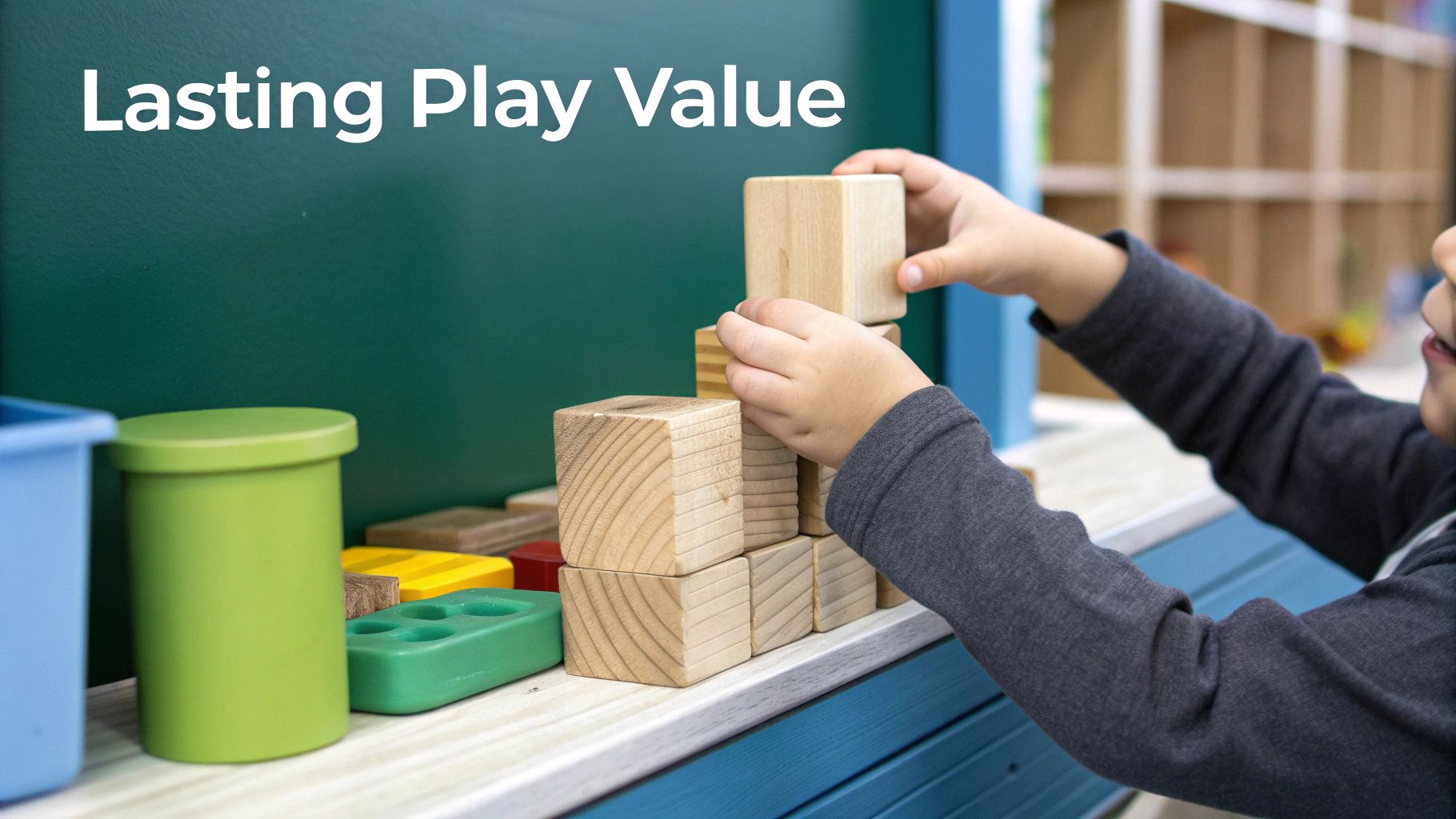
When you're choosing a learning toy for your 2 year old, it's so easy to get distracted by the flashiest gadgets or the ones featuring their favourite cartoon character. But the real worth of a toy isn’t its initial “wow” factor. It’s in its ability to last, to inspire, and to grow with your child. Investing in quality means looking past the surface to find toys that are safe, durable, and offer genuine, long-term play potential.
Think of it like buying a good winter coat. You wouldn't pick one that's flimsy and likely to fall apart after the first snowfall. You'd look for quality materials and a classic design that will see you through the season. The very same principle applies to toys; prioritising solid construction and developmental benefits over flashy, short-lived gimmicks will always be a better investment.
The Power of Open-Ended Play
One of the most valuable ideas to grasp when choosing lasting toys is the difference between "open-ended" and "closed-ended" play. A closed-ended toy is pretty prescriptive; it’s designed to be used in one specific way. That puzzle piece only fits in one spot, or that button-press toy sings the same song every single time. It’s fun for a minute, but the novelty wears off fast.
An open-ended toy, on the other hand, is a blank canvas. It has no single, set purpose. A simple set of wooden blocks is the perfect example of this. One day, they’re a soaring tower. The next, they're a chugging train, and the day after that, they’re little cakes in a pretend kitchen.
This is the kind of play that’s absolutely vital for nurturing creativity and problem-solving skills. Here’s why these toys offer so much more value in the long run:
- They grow with your child: A two-year-old will happily stack blocks, but a four-year-old will use the very same set to build elaborate castles. They stay relevant for years.
- They spark imagination: Without a script to follow, children have to invent their own stories and scenarios, which is fantastic for their creative thinking.
- They encourage independence: Open-ended toys empower children to direct their own play, which is a brilliant way to build confidence and decision-making skills.
An open-ended toy doesn't tell a child what to do; it quietly asks, "What can you imagine?" This simple shift is the foundation of creative, long-lasting play.
Durability and Safety First
Let's be honest, toddlers aren’t exactly known for their gentle touch. Their play is a full-contact sport, often involving dropping, throwing, and even a bit of tasting. A quality toy is one that can withstand all this enthusiastic exploration without breaking or becoming a hazard.
Look for really sturdy construction, using materials like solid wood or high-grade, BPA-free plastic. Safety, of course, is completely non-negotiable. Here in the UK, any reputable toy should carry the UKCA mark, which is your assurance that it meets current safety standards. This means the toy is free from harmful chemicals and doesn't have small parts that could be a choking risk for a child under three.
Striking a Healthy Balance
In a world full of screens, the value of hands-on, physical play has never been more important. While some educational apps can be useful, they just don't engage the senses or develop fine motor skills in the same way that a tangible toy does. Creating a play environment that prioritises physical toys helps to build a healthy balance right from the start.
By focusing on quality, durability, and the magic of open-ended play, you can pick toys that truly support your toddler's development. You’ll be choosing toys that don't just entertain for a week, but become treasured companions on their learning journey.
How to Shop Smart for Toddler Toys
Knowing what makes a great learning toy for a 2-year-old is one thing. Finding it in a busy shop or while scrolling through endless online listings is another challenge altogether. Becoming a smart shopper means learning to look past the bright, noisy packaging and focus on what really matters: safety, quality, and authenticity. It’s about developing an eye for a well-made, secure toy that will genuinely help your child learn and grow.
Once you’ve got this skill, toy shopping stops being a guessing game and becomes a confident choice. And with the UK market for toddler toys growing bigger every year, being discerning has never been more important. In fact, it's expected to generate around £680 million in revenue by 2025, with online sales booming. You can get more details on these toy market trends here, but the bottom line is clear: with so much choice out there, parents need to know how to shop wisely.
Decoding Safety Labels
When you're buying any toy in the United Kingdom, the very first thing you should do is look for the safety markings. These aren't just little logos; they're your guarantee that the toy has passed strict, mandatory safety tests. Think of them as a toy’s passport – proof that it’s safe for your little one to handle.
Here’s what you need to keep an eye out for:
- The UKCA Mark: This is the big one. It's the official safety mark for products sold in Great Britain and confirms the toy meets all the necessary standards, from the materials it's made of to how it's built.
- The CE Mark: You'll probably spot this one too. It shows the toy meets European Union safety standards and often appears alongside the UKCA mark on toys sold in the UK.
Always look for the UKCA mark on the toy itself, its box, or its label. If you can’t find it, that’s a massive red flag. Your best bet is to simply put it back on the shelf and walk away.
Reading Between the Lines Online
Shopping online gives you a fantastic amount of choice, but the one thing you can't do is pick up the toy and give it a good look over. This is where you need to put on your detective hat. You’ll have to rely on product descriptions and, most importantly, customer reviews to sort the gems from the junk.
Don’t just glance at the five-star ratings. Take a few minutes to read through a mix of positive, middling, and negative reviews. You're looking for patterns. Are lots of people saying the paint chips off easily? Did a specific part break for more than one person? On the flip side, if you see review after review from parents praising a toy’s durability and saying how much their two-year-old adores it, you’re probably onto a winner.
Comparing Materials: Wood vs. Plastic
The material a toy is made from really affects its durability, how it feels in your child’s hands, and even its impact on the planet. For toddlers, the choice usually comes down to two main options: wood or plastic. Neither one is automatically better; they just have different strengths.
Wooden Toys:
- Pros: They are incredibly durable, often come from sustainable sources, and have a lovely, classic sensory feel. You also don't have to worry about the plastics or chemicals sometimes found in other toys.
- Cons: They can be a bit pricier and are usually heavier than their plastic cousins.
Plastic Toys:
- Pros: They're lightweight, often more affordable, and can be moulded into all sorts of clever shapes and designs that wood just can't manage.
- Cons: The quality can be all over the place. It's crucial to make sure any plastic toy you buy is made from high-quality, BPA-free plastic.
So, which is best? It really depends on the toy itself and what works for your family. By making safety marks your first check, reading reviews with a critical eye, and understanding the pros and cons of different materials, you can pick out toys that are safe, fun, and built to last.
Your Top Questions Answered
Even with a plan, it's easy to second-guess yourself when you're standing in a toy aisle. Am I buying the right thing? Do they have too much already? It’s completely normal to have these nagging questions.
Here, I’ll tackle some of the most common queries I hear from parents. Think of it as a quick chat to clear up any confusion, helping you feel more confident about the toys you bring into your home. We'll cover everything from toy overload to the great electronics debate.
How Many Toys Does My Two-Year-Old Really Need?
This is the big one, isn't it? The simple truth is that less is nearly always more. A room bursting at the seams with toys can actually be overwhelming for a toddler. When faced with too many choices, they often flit from one thing to the next without ever really getting stuck in.
Instead of counting toys, think about quality and variety. A thoughtfully chosen collection is much better than a mountain of plastic. Aim for a handful of great open-ended toys covering different types of play—something for building, something for make-believe, and a good puzzle or two. You’ll find this encourages much richer, more imaginative play.
A fascinating study on toddlers showed that with fewer toys available, they played with each one for longer and in more creative ways. It’s a great reminder that a minimalist approach can actually boost focus and ingenuity.
Plus, let's be honest, having fewer toys makes tidying up less of a battle for everyone. It’s a win-win that leads to a calmer, more organised play space where real learning can flourish.
Are Electronic Toys a Bad Idea for a Two-Year-Old?
Those flashy, noisy electronic toys are designed to grab a child's attention, but it’s worth being a bit selective. While some can introduce basic concepts like letters and numbers, they’re often what we call "closed-ended." The toy does all the work, leaving very little for your child's imagination to do.
The real problem is that they tend to promote passive entertainment over active thinking. A set of simple wooden blocks, for example, demands that a child plans, creates, and solves problems. An electronic toy often just needs a button to be pushed for a set response. There's no real discovery involved.
Here’s a simple way to think about it:
- Traditional Toys (like blocks or dolls): These get a child’s mind working. They fuel imagination, problem-solving, and fine motor skills.
- Electronic Toys: These can be passive and limit creativity. The constant lights and sounds can also be overstimulating for a little one's developing brain.
Of course, not all technology is bad, but at this age, nothing beats the developmental power of hands-on, tangible play.
What is Toy Rotation and How Do I Get Started?
Toy rotation is a game-changing trick, and it's incredibly simple. All you do is pack away some of your toddler’s toys and then swap them with the ones currently out every few weeks. When the "old" toys make a comeback, they feel brand new and exciting again.
It’s a fantastic way to beat toy boredom without buying anything new. It also keeps your play area much tidier and less cluttered, which is a huge bonus. By focusing on a smaller selection at any one time, you give your child the chance to properly explore each toy, mastering the skills it’s designed to teach.
Ready to discover toys perfectly matched to your child's stage of development? At Grow With Me, we take the guesswork out of playtime. Our curated subscription boxes are filled with high-quality, age-appropriate learning toys designed to inspire. Explore our play kits and give your child the tools they need to thrive.
